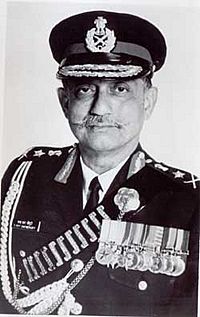Shankar Roychowdhury
Quick facts for kids
General
Shankar Roy Chowdhury
PVSM ADC
|
|
|---|---|
 |
|
| 37th Chairman of the Chiefs of Staff Committee | |
| In office 1 October 1996 – 30 September 1997 |
|
| President | Shankar Dayal Sharma K. R. Narayanan |
| Prime Minister | P. V. Narasimha Rao Atal Bihari Vajpayee H. D. Deve Gowda Inder Kumar Gujral |
| Preceded by | Vijai Singh Shekhawat |
| Succeeded by | Satish Sareen |
| 17th Chief of Army Staff | |
| In office 22 November 1994 – 30 September 1997 |
|
| President | Shankar Dayal Sharma K. R. Narayanan |
| Prime Minister | P. V. Narasimha Rao Atal Bihari Vajpayee H. D. Deve Gowda Inder Kumar Gujral |
| Preceded by | Bipin Chandra Joshi |
| Succeeded by | Ved Prakash Malik |
| Member of Parliament, Rajya Sabha | |
| In office 19 August 1999 – 18 August 2005 |
|
| Constituency | West Bengal |
| Personal details | |
| Born | 6 September 1937 Calcutta, Bengal Province, British India |
| Political party | Indian National Congress |
| Military service | |
| Allegiance | |
| Branch/service | |
| Years of service | 1957–1997 |
| Rank | |
| Unit | 20 Lancers |
| Commands | Army Training Command (ARTRAC) |
| Battles/wars | Indo-Pakistani War of 1965, Bangladesh Liberation War |
| Service number | IC-8417 |
| Awards | |
General Shankar Roy Chowdhury is a very important person in India's history. He used to be the top leader of the Indian Army, called the Chief of Army Staff. After his time in the army, he also served as a member of the Indian Parliament, helping make laws for the country.
Contents
Early Life and Education
Shankar Roy Chowdhury was born in Kolkata, West Bengal, India, on September 6, 1937. His family was from Taki (India). He went to school at St. Xavier's Collegiate School in Kolkata. Later, he studied at Wynberg Allen School and St. George's College, both in Mussoorie. In 1953, he joined the Joint Services Wing of the Indian Armed Forces to train as a cadet.
Military Career Highlights
General Shankar Roy Chowdhury officially joined the Indian Army Armoured Corps on June 9, 1957. He was part of the 20 Lancers unit.
Key Battles and Commands
He bravely fought in two major wars:
- The Indo-Pakistani War of 1965 in the Chamb-Jaurian area.
- The Bangladesh Liberation War in 1971, fighting in Jessore and Khulna.
He led the 20 Lancers from 1974 to 1976. He also commanded an Independent Armoured Brigade and an Armoured Division. From 1991 to 1992, he led the 16 Corps in Jammu and Kashmir.
Training and Leadership Roles
General Roy Chowdhury attended many important military schools. These included the Indian Military Academy and the National Defence Academy. He also studied at the Defence Services Staff College and the Army War College. He even earned a special doctorate degree. He held various important jobs, including being in charge of combat vehicles like the Arjun tank.
Becoming Chief of Army Staff
In August 1992, he became the head of the Army Training Command (ARTRAC). This command is responsible for training all soldiers. On November 22, 1994, he became the 18th Chief of Army Staff for the Indian Army. He took over after the sudden passing of General B.C. Joshi. He served in this top position until September 30, 1997. He retired after 40 years of dedicated service to the military.
Life After the Army
After retiring from the army, General Roy Chowdhury continued to serve his country. He became a member of the Rajya Sabha, which is one of the two houses of the Indian Parliament. There, he spoke about important issues related to defense. Since January 21, 2008, he has also been a director at a company called Indian Metal & Ferro Alloys Ltd. He wrote a book about his life called Officially at Peace, which was published in 2002.
Awards and Decorations
General Shankar Roy Chowdhury received many awards for his brave and excellent service. One of his most important awards is the Param Vishisht Seva Medal. This medal is given for very special service to the Indian Army and the nation.

